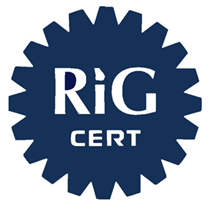ISO 45001 - Occupational health & safety management

ISO 45001 is the world’s leading standard for occupational health and safety management.
Published in 2018, ISO 45001 helps organizations provide safe and healthy workplaces by preventing work-related injuries and ill health, and by proactively improving occupational health and safety (OH&S) performance.
The standard is built on internationally recognized principles. It emphasizes leadership commitment, worker participation, identification and control of OH&S hazards, compliance with legal and other requirements, and continual improvement in safety outcomes.
ISO 45001 is applicable to any organization, regardless of its size, industry, or location. It is used by manufacturers, service providers, public institutions, and NGOs aiming to reduce OH&S risks, enhance employee well-being, and foster a culture of safety.
RIGCERT provides accredited certification services for occupational health and safety management systems in accordance with ISO 45001. Our certification process is transparent and conducted by experienced professionals who understand the specific risks and needs of your industry.
Whether the objective is to reduce incidents, comply with legal obligations, or improve organizational reputation, our ISO 45001 certification can support your commitment to a safer workplace
ISO 45001 is an international standard for occupational health and safety management.
It can be applied by any organization, regardless of its size, type, or the nature of activities. The requirements of ISO 45001 are generic and should be interpreted in the context of the organization, taking into account its specific occupational health and safety (OH&S) risks, legal obligations and operational realities.
Top management support
A critical success factor for an effective occupational health and safety management system is the active leadership and commitment of top management. They are responsible for establishing an OH&S policy and related objectives, promoting a culture of safety across the organization, and ensuring that adequate resources are allocated to implement and maintain the system.
Key requirements of ISO 45001
Implementing an OH&S management system in line with ISO 45001 involves meeting specific requirements set by the standard. One of the first steps is to define and document the scope of the OH&S management system, ensuring that its boundaries and applicability are clearly established.
Organizations must identify OH&S hazards associated with their activities, products, and services that they can control or influence, and determine which of these pose significant OH&S risks. They must also identify their compliance obligations, including legal and other applicable requirements.
Consultation and participation of workers are key ingredients of a succesful OH&S management system. ISO 45001 requires the organization to hear what its employees have to say in relation to the OH&S performance.
Competence and awareness of personnel are also vital. Employees must be properly trained and understand how their roles affect health and safety performance and contribute to achieving OH&S objectives.
Processes must be controlled to ensure that significant OH&S hazards are managed and that activities are carried out under defined and safe conditions. This includes controls related to design, development, or change management.
External providers—including contractors and suppliers—must also be carefully managed to ensure that their activities and associated OH&S risks are properly controlled. When deviations from planned OH&S performance occur, the organization must act to address nonconformities and mitigate any negative impacts on worker safety.
Monitoring and measurement of OH&S performance are essential. Organizations are expected to track relevant indicators, assess compliance, and evaluate progress toward the achievement of OH&S objectives. Internal audits should be conducted at planned intervals to check whether the system is effective and conforms to ISO 45001.
Regular management reviews are required to assess the continuing suitability, adequacy, and effectiveness of the OH&S management system and to ensure alignment with the organization’s strategic direction.
When nonconformities arise, organizations must implement corrective actions to address the root causes and prevent recurrence.
The ISO 45001 certification can be obtained after the organization undergoes a successful audit, conducted in two stages by competent and impartial auditors.
The certification is valid for three years, during which annual surveillance audits are performed to verify that the organization’s OH&S management system continues to meet requirements and it is effectively implemented.
If surveillance audits are missed or reveal major nonconformities that the organization fails to address within the required timeframe, the certification may be suspended or even withdrawn.
At the end of the three-year certification cycle, the organization can choose to undergo a recertification audit, conducted under conditions similar to the initial certification.
We offer accredited certification for Occupational Health and Safety Management Systems in accordance with ISO 45001. Our approach is tailored to the specific needs and operational realities of your organization, ensuring a certification process that is both relevant and efficient.
Our accreditation by ESYD, the Greek National Accreditation Body, guarantees that your ISO 45001 certificate is recognized and accepted by authorities, business partners, and other stakeholders. ESYD is a founding member of both EA (European co-operation for Accreditation) and IAF (International Accreditation Forum), which means that your certification benefits from global recognition and trust.
With RIGCERT, you work with a team of experienced professionals who understand the risks, challenges, and regulatory context of your industry, and who are committed to providing impartial, transparent, and value-driven certification services.





